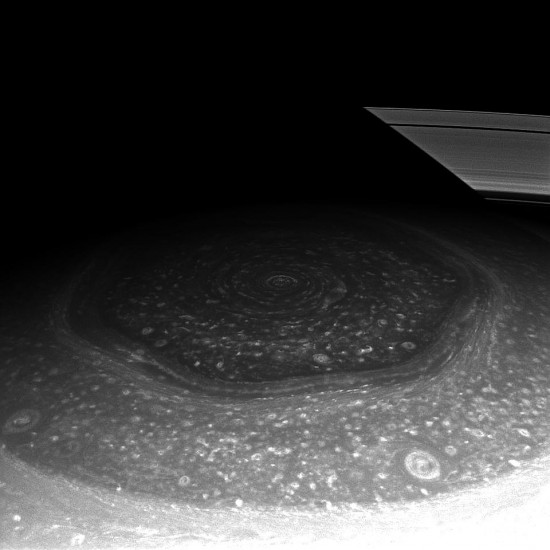Mar 28, 2014
Is the strange polygon at Saturn’s north pole a fluid dynamics phenomenon?
In November 1980, the Voyager 1 spacecraft, now billions of kilometers away from Earth near the Sun’s heliospheric boundary, flew by Saturn. At that time, it recorded an astonishing image, a hexagonal formation in the clouds at the north pole. Saturn’s north pole was tilted away from Earth for many years, preventing ground-based telescopes from obtaining any other images.
On Wednesday, October 15, 1997 a Titan IV-B with a Centaur high-energy upper stage lifted the Cassini spacecraft into Earth orbit in preparation for a multi-year voyage back to Saturn. Cassini entered orbit around Saturn on June 30, 2004. Since then, Cassini took many new images of the Saturnian hexagon, revealing complexities that Voyager was not able to capture. In particular, the concentric ring shapes surrounding the structure and the swirling cloud patterns within it.
Hexagonal and other polygonal shapes are often seen in the eyes of hurricanes, so planetary scientists think that weather patterns on Saturn are responsible for the unusual formation. Several websites recently published laboratory experiments that suggest a fluid dynamics explanation for it. In one experiment, a tank was filled with viscous fluid split into concentric divisions, so that they could be rotated in opposition to each other. As the speed of rotation varied, different features were observed in the liquid. At one point, a hexagon appeared with rotating vortices at each of its sides.
The fluid dynamic experiment seems to provide a plausible description of what is happening on Saturn if several factors are ignored. First, there are concentric rings around the hexagon, each with different temperatures. Second, Saturn’s north and south poles are hotter than theories predict. Third, there are aurorae at the poles. Fourth, there are powerful currents of electric charge entering and leaving Saturn’s poles, connecting it to its family of moons. As previous Picture of the Day articles argue, the plumes of Enceladus, for instance, demonstrate that charge exchange between it and Saturn.
All of these points prove the electrical nature of the Saturnian environment. Simple kinetic experiments, conducted in Earth’s gravity field, are woefully insufficient when the electrical effects are considered. This also leads to another idea: perhaps the polygonal eyes of hurricanes should be reevaluated in the light of electrical theories and not just blowing winds and “Coriolis effect“.
Beams of electricity flowing through plasma produce a central column surrounded by concentric cylinders. The cylindrical filaments create evenly spaced vortices surrounding the column. As the filaments rotate around one another, a preferred hexagonal cross-section forms within the innermost column.
The hexagon at Saturn’s north pole is another example of electrical activity in the Solar System on a tremendous scale. Electricity moves along charged Birkeland current filaments that electrically connect the Sun with its family of planetary bodies. The current energy flows most strongly into the giant gas planets because their charge differential with the Sun is greater than that of their smaller, rocky cousins.
The electric Sun is what drives the energetic meteorological phenomena on Saturn. Electrical circuits power the Sun and initiate the anomalous heating that has been found on Saturn, as well as on the other gas planets.
Stephen Smith
Click here for a Spanish translation













